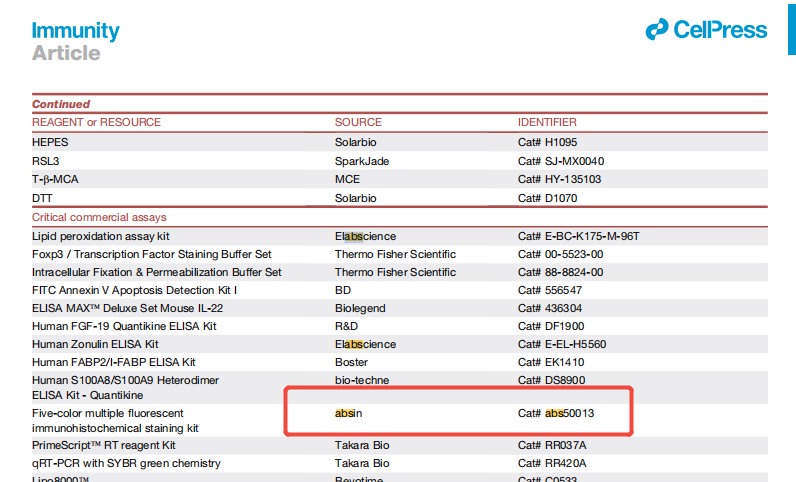- Cart 0
- English
[IF25.5] Absin helps new therapeutic targets for neonatal necrotizing enterocolitis: intestinal FXR and ferroptosis
August 19, 2025
Clicks:109
Neonatal necrotizing enterocolitis (NEC) is a common and fatal intestinal disease in premature infants, but its mechanism has not been fully elucidated. A recent title published in Immunity: "Bile acid receiver FXR promotes intestinal epithelial ferroptosis and subsequent ILC3 dysfunction in neonatal necrotizing enterocolitis" Studies have revealed the molecular mechanism of bile acid receptor FXR exacerbating NEC by regulating ferroptosis and ILC3 dysfunction in intestinal epithelial cells, and proposed potential therapeutic targets.
And the five-color multiplex fluorescent staining kit #abs50013 provided by Absin Company was used

This article takes you to analyze the key technologies, experimental design and core conclusions of this research.
1. Panorama of core experimental technologies
This study integrates multi-omics technology and cutting-edge molecular biology methods to verify scientific hypotheses layer by layer:
01 Single cell RNA sequencing (scRNA-seq)
The transcriptome heterogeneity of NEC mouse intestinal epithelial cells (IECs) was analyzed, and the specific high expression of FsXR in enterocytes was locked.
02 Flow cytometry and sorting
FXR protein expression in IECs was detected, and ILC3 (CD 45 ⁺ Lin ⁻ CD 90. 2 ⁺ CD 127 ⁺ KLRG 1 ⁻) was sorted for functional analysis.
03 Multiplex fluorescence immunohistochemistry (mIHC)
Panel design:
FGF19 localization: FGF19 (red) + EpCAM (white, labeled epithelial cells) + DAPI (blue, nuclear staining).
FXR and lipid peroxidation: FXR (red) + 4-HNE (green, lipid peroxidation marker) + EpCAM (white) + DAPI (blue).
Colocalization analysis reveals spatiotemporal association between FXR and oxidative damage in the gut of NEC patients.
04 Lipidomics (LC-MS/MS)
Phospholipid peroxides (PE-PUFAs) were quantified, confirming that FXR promotes ferroptosis by upregulating ACSL4.
05 Gene editing and animal models
Gut-specific Fxr knockout mice (Fxr ^ AlEC) were constructed, combined with NEC-induced models (hypoxia + hypothermia + formula feeding).
06 Chromatin immunoprecipitation (ChIP) and luciferase report
It was verified that FXR directly binds to ACSL4 promoter and regulates its transcriptional activity.
2. Sample grouping logic
The study was validated in both clinical cohorts and animal models:
01 Clinical samples
NEC group: 6 children with surgically confirmed NEC (plasma, intestinal tissue).
Control group: 6 age-matched children with non-NEC (normal intestinal segments were taken during surgery for congenital intestinal malformations).
02 Mouse experiment
Genotype grouping: FXR ^ AlEC (intestinal FXR knockout) vs. Fxr ^ fl/fl (wild-type control).
Intervention grouping:
FXR regulation: agonist Fexaramine, antagonist Gly-β-MCA.
Ferroptosis interventions: inhibitor Liproxstatin-1, ACSL4 inhibitor PRGL493.
Microbial intervention: microbial transplantation + butyric acid supplementation in children with NEC.
3. Subversive conclusions
01 FXR is a key driver of NEC
Intestinal FXR expression in children with NEC was significantly elevated and positively correlated with plasma FGF19 (a downstream target of FXR), suggesting that FXR activation exacerbates the disease.
02 Imbalance of microorganism-epithelial cell interaction
NEC-associated dysbacteriosis reduces short-chain fatty acids (SCFAs, such as butyric acid), uninhibiting their inhibition of FXR, resulting in intestinal epithelial ferroptosis.
03 Ferroptosis-ILC3 axis worsens inflammation
FXR activates ACSL4 through transcription, promoting lipid peroxidation and ferroptosis; Oxidized phospholipids (PEox) released by dead epithelial cells inhibit IL-22 secretion by ILC3 and impair intestinal barrier repair.
04 New treatment strategies
Targeted inhibition of intestinal FXR, ACSL4, or ferroptosis significantly alleviated NEC symptoms and improved survival by more than 50% in mice.
4. Clinical translation enlightenment
01 Diagnostic markers : Plasma FGF19 and lipid peroxide (LPO) may become early warning indicators of NEC.
02 Treatment direction : develop intestinal-specific FXR antagonists (such as Gly-β-MCA) or ferroptosis inhibitors, or regulate the flora through probiotics/butyric acid
Sum up
This study reveals for the first time the central role of the FXR-ferroptosis-ILC3 axis in NEC, providing a new perspective for understanding the molecular mechanism of intestinal inflammation, and providing precise targets for clinical intervention. The combination of multi-omics technology and cross-species models highlights the powerful power of translational medicine research.
Absin provides antibodies, proteins, ELISA kits, cell culture, detection kits, and other research reagents. If you have any product needs, please contact us.
|
Absin Bioscience Inc. Email: worldwide@absin.net |
 Follow us on Facebook: Absin Bio Follow us on Facebook: Absin Bio |
